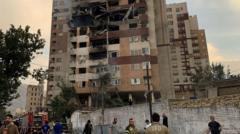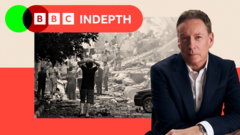The ongoing conflict between Iran and Israel intensified on June 13, 2025, as Iran launched missiles hitting several sites in Tel Aviv after Israel's targeted airstrikes on critical Iranian nuclear facilities. The strikes resulted in injuries, fears of broader conflict, and international diplomatic efforts to ease the escalating tensions.
Escalating Tensions: Iran and Israel Exchange Strikes Amid Growing Global Concern

Escalating Tensions: Iran and Israel Exchange Strikes Amid Growing Global Concern
Iranian missiles struck multiple sites in Tel Aviv, injuring civilians, following Israel's devastating airstrikes targeting Iran’s nuclear facilities, escalating the conflict significantly.
The article text:
In a significant escalation of conflict, Iranian ballistic missiles struck several locations near Tel Aviv on the evening of June 13, 2025, resulting in injuries to at least 22 individuals, according to Israeli military reports. This retaliatory action follows Israel's aggressive air assaults on Iranian military targets, which had already left considerable damage in Iran, including attacks on a pivotal nuclear enrichment facility near Natanz.
Eyewitness accounts and video footage depicted explosions across Tel Aviv's skyline, particularly in the Kirya district, which houses military installations. In addition to the physical damage to structures, ambulances scrambled to treat civilians affected by the blasts, with reports of moderate injuries being treated in surrounding hospitals. Fire officials confirmed rescuing people trapped in damaged buildings.
While Israeli air defenses managed to intercept several incoming missiles, many still struck populated areas, raising fears of further escalations. Defense Minister Israel Katz condemned Iran's actions, stating that they had crossed a "red line" and warning of severe repercussions for the Iranian government.
The UN nuclear watchdog, led by Rafael Grossi, confirmed that Israel's initial airstrikes had successfully destroyed above-ground components of the Natanz facility. However, Grossi noted radiation and chemical contamination, deeming it manageable for Iran's authorities. Following these revelations, multiple other Iranian military facilities, including those in Fordo and Isfahan, reported undergoing attacks, suggesting a broader Israeli military campaign aimed at crippling Iran's nuclear capabilities.
Diplomatic channels have rapidly intensified, with President Trump speaking with both Israeli Prime Minister Benjamin Netanyahu and other world leaders, advocating measured responses to prevent further escalation. Meanwhile, European leaders, including the UK's Prime Minister Keir Starmer, urged both nations for restraint, reflecting a growing global anxiety about the unravelling conflict.
As Iran reiterated its commitment to retaliate for what it termed "unprovoked attacks," regional instability looms, threatening not only the countries involved but potentially escalating into a wider regional conflict.
With foreign military involvement becoming evident, including U.S. support for missile interceptions, the situation remains fluid. Israel is reportedly eyeing further operations against Iran’s most fortified sites, underscoring the dire implications of this ongoing cycle of military strikes and counterstrikes.
As the conflict continues to unfold, world leaders are closely monitoring the implications for peace and stability in the Middle East, where historical animosities threaten to exacerbate current tensions.
In a significant escalation of conflict, Iranian ballistic missiles struck several locations near Tel Aviv on the evening of June 13, 2025, resulting in injuries to at least 22 individuals, according to Israeli military reports. This retaliatory action follows Israel's aggressive air assaults on Iranian military targets, which had already left considerable damage in Iran, including attacks on a pivotal nuclear enrichment facility near Natanz.
Eyewitness accounts and video footage depicted explosions across Tel Aviv's skyline, particularly in the Kirya district, which houses military installations. In addition to the physical damage to structures, ambulances scrambled to treat civilians affected by the blasts, with reports of moderate injuries being treated in surrounding hospitals. Fire officials confirmed rescuing people trapped in damaged buildings.
While Israeli air defenses managed to intercept several incoming missiles, many still struck populated areas, raising fears of further escalations. Defense Minister Israel Katz condemned Iran's actions, stating that they had crossed a "red line" and warning of severe repercussions for the Iranian government.
The UN nuclear watchdog, led by Rafael Grossi, confirmed that Israel's initial airstrikes had successfully destroyed above-ground components of the Natanz facility. However, Grossi noted radiation and chemical contamination, deeming it manageable for Iran's authorities. Following these revelations, multiple other Iranian military facilities, including those in Fordo and Isfahan, reported undergoing attacks, suggesting a broader Israeli military campaign aimed at crippling Iran's nuclear capabilities.
Diplomatic channels have rapidly intensified, with President Trump speaking with both Israeli Prime Minister Benjamin Netanyahu and other world leaders, advocating measured responses to prevent further escalation. Meanwhile, European leaders, including the UK's Prime Minister Keir Starmer, urged both nations for restraint, reflecting a growing global anxiety about the unravelling conflict.
As Iran reiterated its commitment to retaliate for what it termed "unprovoked attacks," regional instability looms, threatening not only the countries involved but potentially escalating into a wider regional conflict.
With foreign military involvement becoming evident, including U.S. support for missile interceptions, the situation remains fluid. Israel is reportedly eyeing further operations against Iran’s most fortified sites, underscoring the dire implications of this ongoing cycle of military strikes and counterstrikes.
As the conflict continues to unfold, world leaders are closely monitoring the implications for peace and stability in the Middle East, where historical animosities threaten to exacerbate current tensions.


















